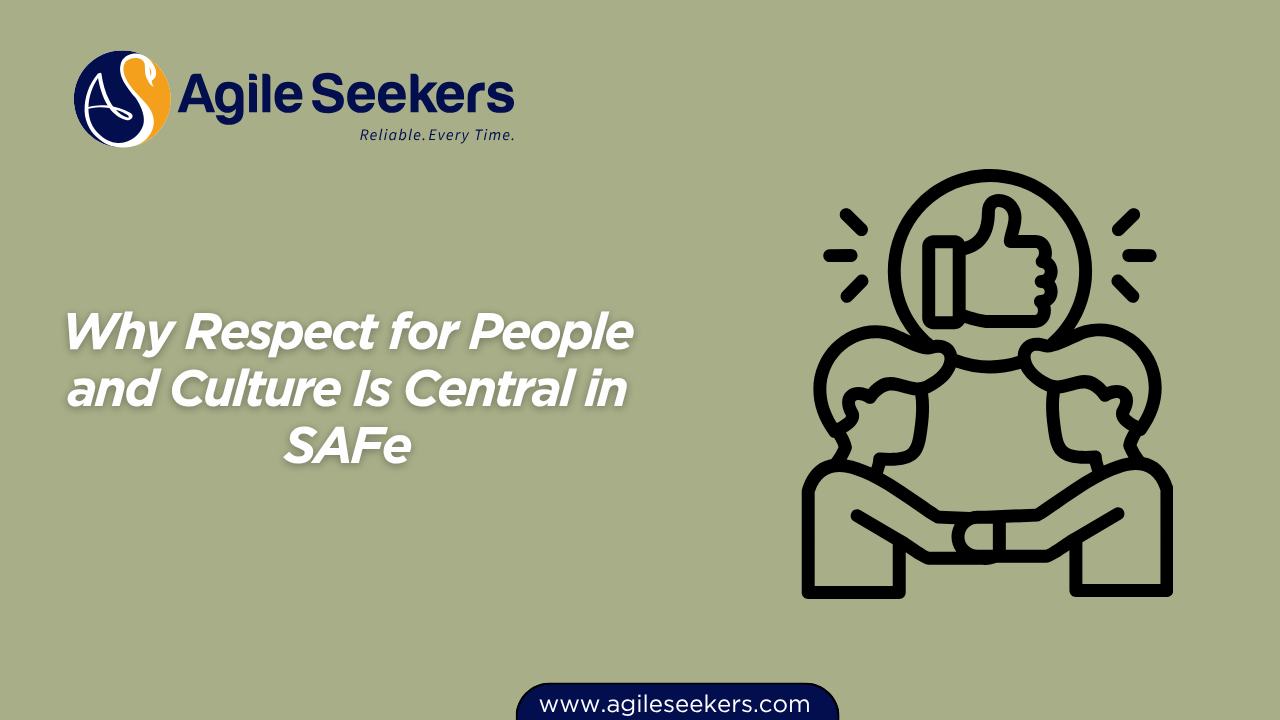Why Respect for People and Culture Is Central in SAFe

Start with this, SAFe’s roots are in Lean, where respect for people and culture sits at the heart of everything. It’s not just about politeness or diversity programs. It’s about genuinely valuing every person’s ideas, time, and growth—and intentionally shaping a culture where collaboration, learning, and improvement are real priorities.
In SAFe, respect is visible when leaders listen instead of dictate, when teams feel safe to challenge each other, and when people are empowered to solve problems, not just follow instructions.
Why SAFe Puts Respect for People and Culture Front and Center
Here’s the thing: If you want organizational agility to last, you need more than frameworks, backlogs, and ceremonies. You need an environment where people bring their best selves to work.
Let’s break down why respect is so central:
1. People Are the Source of All Value
Every product, every innovation, every ounce of improvement comes from people. SAFe recognizes that the collective intelligence of teams beats rigid hierarchy or top-down management every time. When people feel respected, they’re more engaged, more willing to experiment, and more likely to stick around.
Want to learn how leaders drive this in SAFe? See Leading SAFe Agilist Certification Training.
2. Culture Eats Strategy for Breakfast
You can have the best strategies, playbooks, or tech—but if your culture is toxic, none of that matters. Respect for people and culture creates psychological safety, which is the foundation for trust, innovation, and healthy conflict. Teams that feel safe will speak up about risks, challenge old ways, and spot improvement opportunities early.
3. Respect Unlocks Relentless Improvement
You can’t improve what you’re not willing to talk about. When teams and leaders respect each other, feedback flows both ways. Retrospectives become honest and useful, not just another meeting. People try new things, share failures, and learn together. That’s how you get continuous improvement at scale.
If you’re interested in how Product Owners and Product Managers can foster this environment, check out SAFe Product Owner Product Manager (POPM) Certification.
4. Respect Is the Glue in Cross-Functional Collaboration
SAFe is built on the idea of cross-functional teams and ARTs (Agile Release Trains). Respect cuts across roles, departments, and backgrounds. If you don’t have it, handoffs become blame games, and silos harden.
A culture of respect helps Scrum Masters protect the team’s health and flow. Read more at SAFe Scrum Master Certification.
5. It Reduces Waste—Seriously
Ever seen teams redo work because they’re afraid to admit they missed something? Or leaders micromanage because they don’t trust their teams? That’s massive waste. Respect for people eliminates this by encouraging open communication and shared ownership.
How Does Respect for People and Culture Show Up in SAFe?
Here’s where theory meets the floor. Let’s look at how SAFe bakes this into its DNA:
Decentralized Decision-Making
Teams are empowered to make decisions as close to the work as possible. This signals trust and respect for their expertise, not just their hands.
Servant Leadership
Leaders in SAFe aren’t taskmasters—they’re coaches, blockers-removers, and champions of growth. The shift from command-and-control to servant leadership is core to Agile transformation. Advanced Scrum Masters get deep into this at SAFe Advanced Scrum Master Certification Training.
Transparency Everywhere
From backlogs to PI objectives, everything’s out in the open. Respect is about giving people context and letting them see the “why,” not just the “what.”
Inspect & Adapt
Feedback loops are baked into every level. Respect means acting on that feedback, not just collecting it.
Growth Mindset and Learning Culture
Failure isn’t punished—it’s mined for learning. Training, certifications, and communities of practice keep people growing. The best organizations create time and space for learning as part of the job.
What Happens When Respect Is Missing?
Let’s call it out: No respect, no agility. Here’s what you see instead:
-
High turnover. People leave for workplaces where they feel valued.
-
Low engagement. Teams do the minimum, keep their heads down, and stop caring.
-
Blame culture. Problems get hidden instead of fixed.
-
Stuck improvement. No one takes risks or shares new ideas.
-
Transformation fatigue. Agile starts to feel like another failed management fad.
Bringing Respect to Life: What Real Organizations Do
Make It Explicit in Values and Behaviors
Don’t assume people know what “respect” means. Make it visible in values, reward systems, and leadership behaviors.
Train Leaders at Every Level
Invest in programs that teach servant leadership and emotional intelligence—not just process and tools. For deep dives into building agile leadership, explore SAFe Release Train Engineer Certification Training.
Reward Collaboration, Not Just Results
Celebrate teams that help each other, share knowledge, and work across silos.
Support Growth for Everyone
Provide real training, mentorship, and career growth—not just for a chosen few.
Listen—and Act on Feedback
Regularly check in with teams, act on suggestions, and make it safe to voice concerns.
Final Thoughts: Why This Is Non-Negotiable in SAFe
Respect for People and Culture isn’t a side note in SAFe—it’s a core value. Without it, agile collapses into empty process. With it, you get teams that are engaged, creative, and resilient—ready to deliver real value, even as things change.
If you’re serious about building a truly agile organization, put respect at the center of everything. Process and tools matter, but people and culture are the engine. That’s the real difference between teams who survive change and those who actually shape it.
Want to start shaping this culture in your organization? Take a deeper look at SAFe certifications like Leading SAFe Agilist, SAFe POPM, SAFe Scrum Master, Advanced Scrum Master, and Release Train Engineer. Each of these digs deep into the people side of agility.
And for further reading, check out SAFe’s official take on Core Values and Lean.org’s resources.
Ready to put respect into action? That’s where real transformation begins.
Also read - The Role of Leadership in Fostering a Lean Agile Mindset
Also see - How SAFe Core Values Drive Business Agility




















